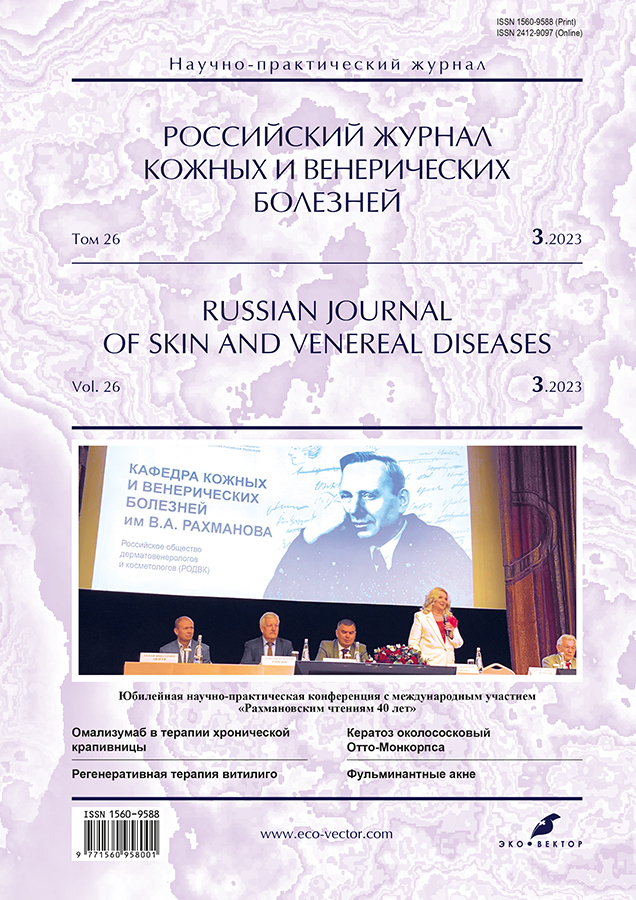Justification of the efficacy of combined therapy with dupilumab and cyclosporine in children with severe dermato-respiratory syndrome
- Authors: Aoun R.Y.1, Udzhukhu V.Y.2, Kukalo S.V.2, Batkaev E.A.1
-
Affiliations:
- Peoples' Friendship University of Russia
- The Russian National Research Medical University named after N.I. Pirogov
- Issue: Vol 26, No 3 (2023)
- Pages: 307-314
- Section: DERMATOLOGY
- Submitted: 20.03.2023
- Accepted: 20.04.2023
- Published: 22.06.2023
- URL: https://rjsvd.com/1560-9588/article/view/321476
- DOI: https://doi.org/10.17816/dv321476
- ID: 321476
Cite item
Abstract
BACKGROUND: Atopic dermatitis is characterized by a clear upward trend in the prevalence and development of severe forms of dermatosis, which represents an important medical and social problem.
AIM: Pathogenetic justification and study of clinical efficacy of combined use of dupilumab and cyclosporine in children with severe refractory atopic dermatitis.
MATERIALS AND METHODS: The study included 30 children and adolescents over 6 years of age, with a diagnosis of atopic dermatitis with severe disease severity. The control group consisted of 15 people. EASI, Pruritus VAS score, CDLQI index were used to assess the dynamics of disease symptoms. The content of interleukins in blood serum was determined by enzyme immunoassay. Children included in the study were divided into two groups of 15 patients by randomization. Group 1 patients received dupilumab monotherapy, Group 2 patients were treated with a combination of dupilumab and cyclosporine.
RESULTS: Positive dynamics in the course of the cutaneous pathological process was observed in all patients. A more pronounced and persistent tendency to further decrease of EASI values was preserved in patients receiving combined therapy. During dupilumab monotherapy and combined treatment there was a significant reduction in nasal obstruction, a decrease in the number of bronchial obstruction/cough attacks. In the course of therapy in all patients it was possible to achieve a significant reduction in the negative impact of atopic dermatitis on the quality of life of children and adolescents. Dupilumab therapy contributed to normalization of cytokine status, eosinophil levels and total immunoglobulin E. However, after 12 weeks of dupilumab monotherapy, signs of Th1-response activation were revealed.
CONCLUSION: Combined therapy reduces the duration of treatment with dupilumab to 12 weeks, avoids side effects and complications, and significantly increases clinical efficacy of therapeutic measures in children and adolescents with severe atopic dermatitis.
Full Text
About the authors
Rami Yu. Aoun
Peoples' Friendship University of Russia
Email: dr.ramiaoun@hotmail.com
ORCID iD: 0009-0000-4695-8060
SPIN-code: 5321-7870
Postgraduate Student
Russian Federation, MoscowVladislav Yu. Udzhukhu
The Russian National Research Medical University named after N.I. Pirogov
Email: sovet140011@mail.ru
ORCID iD: 0000-0002-3351-9138
SPIN-code: 2066-2303
MD, Dr. Sci. (Med.), Professor
Russian Federation, MoscowSvetlana V. Kukalo
The Russian National Research Medical University named after N.I. Pirogov
Email: Svetlana_kukalo@inbox.ru
ORCID iD: 0000-0002-2639-6811
SPIN-code: 3711-3460
MD, Cand. Sci. (Med.), Associate Professor
Russian Federation, MoscowEdgem A. Batkaev
Peoples' Friendship University of Russia
Author for correspondence.
Email: batkaeved@yandex.ru
ORCID iD: 0000-0001-6702-6991
SPIN-code: 6110-3366
MD, Dr. Sci. (Med.), Professor
Russian Federation, MoscowReferences
- Hadi HA, Tarmizi AI, Khalid KA, et al. The epidemiology and global burden of atopic dermatitis: A narrative review. Life (Basel). 2021;11(9):936. doi: 10.3390/life11090936
- Raimondo A, Lembo S. Atopic dermatitis: Epidemiology and clinical phenotypes. Dermatol Pract Concept. 2021;11(4):e2021146. doi: 10.5826/dpc.1104a146
- Thomsen SF. Atopic dermatitis: Natural history, diagnosis, and treatment. ISRN Allergy. 2014;2014:354250. doi: 10.1155/2014/354250
- Sacotte R, Silverberg JI. Epidemiology of adult atopic dermatitis. Clin Dermatol. 2018;36(5):595–605. doi: 10.1016/j.clindermatol.2018.05.007
- Weidinger S, Beck LA, Bieber T, et al. Atopic dermatitis. Nat Rev Dis Primers. 2018;4(1):1. doi: 10.1038/s41572-018-0001-z
- David Boothe W, Tarbox JA, Tarbox MB. Atopic dermatitis: Pathophysiology. Adv Exp Med Biol. 2017;(1027):21–37. doi: 10.1007/978-3-319-64804-0_3
- Kim J, Kim BE, Leung DY. Pathophysiology of atopic dermatitis: Clinical implications. Allergy Asthma Proc. 2019;40(2):84–92. doi: 10.2500/aap.2019.40.4202
- Sroka-Tomaszewska J, Trzeciak M. Molecular mechanisms of atopic dermatitis pathogenesis. Int J Mol Sci. 2021;22(8):4130. doi: 10.3390/ijms22084130
- Munera-Campos M, Carrascosa JM. Innovation in atopic dermatitis: From pathogenesis to treatment. Actas Dermosifiliogr (Engl Ed). 2020;111(3):205–221. doi: 10.1016/j.ad.2019.11.002
- Torres T, Ferreira EO, Gonçalo M, et al. Update on atopic dermatitis. Acta Med Port. 2019;32(9):606–613. doi: 10.20344/amp.11963
- Klonowska J, Gleń J, Nowicki RJ, et al. New cytokines in the pathogenesis of atopic dermatitis-new therapeutic targets. Int J Mol Sci. 2018;19(10):3086. doi: 10.3390/ijms19103086
- Hrestak D, Matijašić M, Paljetak ČH, et al. Skin microbiota in atopic dermatitis. Int J Mol Sci. 2022;23(7):3503. doi: 10.3390/ijms23073503
- Hülpüsch C, Tremmel K, Hammel G, et al. Skin pH-dependent Staphylococcus aureus abundance as predictor for increasing atopic dermatitis severity. Allergy. 2020;75(11):2888–2898. doi: 10.1111/all.14461
- Gandhi NA, Pirozzi G, Graham NM. Commonality of the IL-4/IL-13 pathway in atopic diseases. Expert Rev Clin Immunol. 2017;13(5):425–437. doi: 10.1080/1744666X.2017.1298443
- Cather J, Young M, Di Ruggiero DC, et al. A review of phase 3 trials of dupilumab for the treatment of atopic dermatitis in adults, adolescents, and children aged 6 and up. Dermatol Ther (Heidelb). 2022;12(9):2013–2038. doi: 10.1007/s13555-022-00778-y
- Newsom M, Bashyam AM, Balogh EA, et al. New and emerging systemic treatments for atopic dermatitis. Drugs. 2020;80(11):1041–1052. doi: 10.1007/s40265-020-01335-7
- Butala S, Castelo-Soccio L, Seshadri R, et al. Biologic versus small molecule therapy for treating moderate to severe atopic dermatitis: Clinical considerations. J Allergy Clin Immunol Pract. 2023:11(5):1361–1373. doi: 10.1016/j.jaip.2023.03.011
- Wollenberg A, Blauvelt A, Guttman-Yassky E, et al. Tralokinumab for moderate-to-severe atopic dermatitis: Results from two 52-week, randomized, double-blind, multicentre, placebo-controlled phase III trials (ECZTRA 1 and ECZTRA 2). Br J Dermatol. 2021;184(3):437–449. doi: 10.1111/bjd.19574
- Simpson EL, Papp KA, Blauvelt A, et al. Efficacy and safety of upadacitinib in patients with moderate to severe atopic dermatitis: analysis of follow-up data from the measure up 1 and measure up 2 randomized clinical trials. JAMA Dermatol. 2022;158(4):404–413. doi: 10.1001/jamadermatol.2022.0029
Supplementary files









